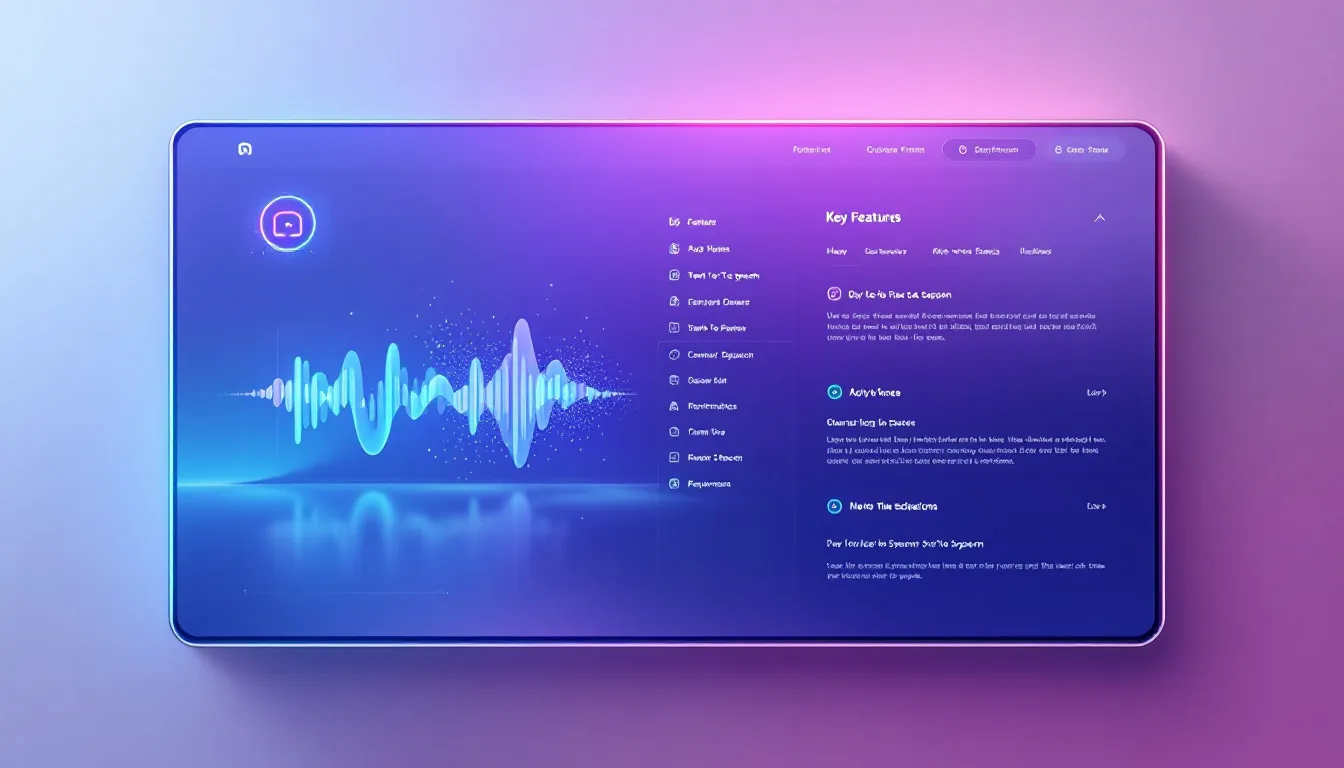Need to find the best text to speech system? Low latency is crucial in TTS systems as it contributes to seamless user interactions, and factors like speech synthesis and voice quality play a significant role in evaluating these systems. This article walks you through a comprehensive text to speech test. Learn how to pick the right text, choose ideal voices, and evaluate naturalness. Get ready to understand key features and see real-world applications of TTS technology.
.jpg)
Need to find the best text to speech system? Low latency is crucial in TTS systems as it contributes to seamless user interactions, and factors like speech synthesis and voice quality play a significant role in evaluating these systems. This article walks you through a comprehensive text to speech test. Learn how to pick the right text, choose ideal voices, and evaluate naturalness. Get ready to understand key features and see real-world applications of TTS technology.
Text to Speech (TTS) is a transformative technology that converts written text into spoken words, allowing users to listen to written content in a natural-sounding voice. This technology leverages artificial intelligence (AI) and machine learning algorithms to synthesize human-like speech from text, focusing on both speech synthesis and voice quality, making it an invaluable tool for individuals with visual impairments, reading difficulties, or those who prefer to consume information through audio.
TTS technology has evolved significantly since its inception. Early versions were often robotic and monotonous, but advancements in AI and machine learning have led to the development of more natural-sounding voices and improved speech synthesis. Today, TTS is widely used in various applications, including virtual assistants, language learning platforms, audiobooks, and customer service chatbots. These applications demonstrate the versatility and importance of TTS in modern digital interactions.
Using Text to Speech software offers numerous benefits, making it a powerful tool for both personal and professional use. Here are some key advantages:
Some popular applications of TTS software include:
Overall, Text to Speech technology has revolutionized the way we consume written content, making it more accessible, convenient, and engaging. Whether for personal use or business applications, TTS offers a range of benefits that enhance communication and interaction in the digital age.

Testing TTS systems ensures they deliver high-quality, natural-sounding voices by focusing on speech synthesis and voice quality. The process involves selecting the right text, choosing supported voices, and evaluating humanlike voices. These steps allow users to effectively assess TTS capabilities, enhancing their voice user interface experience.
But how do we go about this? Let’s break it down.
The first step in a TTS test is choosing appropriate written content. The goal is to use clear and concise text to accurately evaluate the system’s performance. Voice quality is assessed through selected text to ensure clarity and naturalness.
Utilizing Speech Synthesis Markup Language (SSML) tags enhances output quality by allowing customizations like pauses and pronunciation instructions. Carefully selected text ensures the TTS system provides a realistic reading experience.
Next, exploring the variety of supported voices offered by speech synthesis in TTS systems is crucial. These systems provide a range of voices, such as English (US) options like AWARE, Lizzy, and Molly, allowing users to choose based on accent, tone, and style. The right selection, whether a regional accent or a gender-specific voice, significantly impacts the voice user interface’s quality.
This variety ensures the TTS system can cater to diverse user preferences with natural-sounding voices.
The final step is evaluating humanlike voices. Low latency is crucial in ensuring responsive and engaging user interactions. High-quality, natural-sounding voices enhance user experience. Speechify, for instance, uses advanced technology to deliver text effectively. Additionally, voice quality significantly impacts user experience by making interactions more pleasant and natural.
When assessing tts voices systems, listen for clarity, intonation, and emotional expressiveness to ensure the voices sound human like speech. This human like speech makes interactions more relatable and engaging.

Text to Speech tools offer numerous features designed to enhance user experience, including advanced speech synthesis and improved voice quality. From custom voice creation to neural and WaveNet voice support, these tools continually evolve. Understanding these features helps users make informed decisions when selecting a TTS tool.
Let’s delve into some of the key features that make these tools stand out.
A standout feature of modern TTS tools is custom voice creation. This involves using custom audio recordings to create unique, natural-sounding voices. Training custom voice models allows businesses to develop a voice that uniquely represents their brand across all customer touchpoints. Voice quality is crucial for custom voices, ensuring they sound natural and engaging.
This personalization enhances the user experience and ensures consistency in communication.
Support for Speech Synthesis Markup Language (SSML) is another crucial feature. SSML allows detailed customization of speech, enabling control over aspects like delivery and pronunciation. This ensures the output is clear, engaging, and suited to the content’s specific needs.
Whether adding pauses or formatting numbers, SSML customization plays a vital role in the effectiveness of TTS tools.
Advancements in TTS technology have led to the development of neural and WaveNet voices. These technologies enhance the naturalness and expressiveness of synthesized speech. Neural2 voices, powered by the latest research, offer a more lifelike and engaging experience. Leveraging these advancements, TTS systems can deliver speech that closely mimics human intonation and emotion. Additionally, the 'voice quality' is significantly improved by neural and WaveNet voices, making the speech sound more natural and pleasant.

Speech synthesis technology has vast and varied applications, impacting sectors from accessibility to content creation by improving voice quality. Converting written content into spoken words enhances engagement and accessibility.
Let’s explore how different industries are leveraging this powerful technology to improve user experience and communication.
Text-to-speech technology revolutionizes digital accessibility, providing auditory access to content for users with disabilities, including those with visual impairments. It supports individuals with reading difficulties, dyslexia, and cognitive challenges by converting written words into spoken language. Voice quality plays a crucial role in enhancing accessibility by ensuring clear and understandable audio output for all users.
E-learning websites use TTS to provide audio narration for written content, making learning more inclusive. This enhancement ensures that all users can benefit from digital content, regardless of their limitations.
In customer service, TTS technology and speech synthesis are revolutionizing interactive voice response (IVR) systems. By making automated interactions more efficient and user-friendly, TTS enhances overall customer interactions. Organizations can adapt custom voices to meet evolving branding needs, ensuring consistent and personalized communication.
This leads to smoother and more effective customer interactions.
Content creators are leveraging TTS technology to create dynamic voiceovers for various media formats like videos and podcasts. This enables the quick production of audio files versions of written materials, making content more accessible to auditory learners. Voice quality enhances media production by providing clear and engaging audio experiences.
TTS is used to create audiobooks, allowing authors to reach audiences who prefer listening over reading. This versatility makes TTS a valuable tool in the media industry.

Several popular TTS solutions available today offer unique features and capabilities in speech synthesis and voice quality. From Google’s advanced deep learning models to Speechify’s comprehensive API, these tools push the boundaries of TTS technology. TTSReader, for instance, has been turning textual content into audio since 2015, showcasing its long-standing presence in the market.
Let’s take a closer look at some of the leading solutions in the market.
Google Cloud Text-to-Speech API uses advanced speech synthesis to convert text into natural-sounding speech. It features a voice user interface that allows for easy interaction and personalization based on user preferences, including a variety of voice options like English (US). New customers can take advantage of $300 in free text credits, with pricing based on the number of characters processed each month.
This makes it a cost-effective option for many users.
ElevenLabs AI Voice Generator stands out for its speed and simplicity in application development. The importance of low latency in ensuring seamless user interactions and enhanced audio experiences cannot be overstated. It supports 32 languages and can produce any voice, style, and language, enhancing content creation and user retention. The ElevenLabs AI voice generator produces speech with human intonation and inflections, ensuring high fidelity. Voice quality significantly enhances user experience by providing clear and natural-sounding audio.
The voice generator adjusts its delivery based on context, ensuring the output matches the intended message. This flexibility makes it a versatile tool for various applications.
Speechify TTS API is recognized for its affordability and wide platform availability, including Chrome, iOS, Android, Mac, and Windows. Leveraging advanced speech synthesis, the sales team plays a crucial role in facilitating bulk purchases for organizations, highlighting the accessibility and benefits of Speechify TTS API services. Users can save up to 9 hours a week by using Speechify, making it a time-efficient solution. The API supports multiple languages, enhancing usability for diverse users. Additionally, Speechify is available for free on Chrome, iOS, Android, Mac, and Windows, making it accessible to a broad audience.
This comprehensive feature set makes Speechify a strong contender in the TTS market.
Speech synthesis technology has significantly impacted various sectors, enhancing voice quality, accessibility, and facilitating communication. From e-learning platforms to corporate training and media production, TTS is transforming content delivery and consumption.
Let’s explore some real-world examples of how TTS is being used effectively.
Educational platforms are using TTS to convert written content into audio, making learning more engaging and inclusive. This supports auditory learners and students with reading challenges by providing vocal support for written content. Voice quality enhances educational content by making it clearer and more enjoyable for students.
By integrating TTS, educational websites improve student interaction and comprehension, ensuring a better learning experience for all.
In corporate environments, TTS technology, including speech synthesis, provides scalable solutions for efficiently delivering training materials. It enhances engagement and retention of information among employees by adapting content delivery to different learning styles.
Companies can use TTS for announcements and updates, ensuring information reaches all employees effectively. This leads to a more informed and productive workforce.
In media production, TTS enhances storytelling by providing voiceovers for characters or narrations in multimedia productions. This cost-effective and efficient technology allows content creators to reach wider audiences. Integrating TTS in media significantly increases audience engagement and satisfaction by making content more accessible. Voice quality also plays a crucial role in enhancing media production, ensuring that the audio output is clear and engaging.
This makes TTS an invaluable tool in the media and entertainment industry.

The future of TTS technology is bright, with exciting advancements in speech synthesis and voice quality on the horizon. From multilingual support to emotion and context-aware TTS, these trends aim to make TTS more intuitive and user-focused.
Let’s delve into some of the key trends that are shaping the future of TTS technology.
Recent advancements in TTS technology, including speech synthesis, aim to incorporate a wider variety of languages and dialects, increasing accessibility for non-English speakers. However, current multilingual tools often struggle with accurate translation and contextual relevance.
Addressing these challenges will enable multilingual TTS to facilitate better communication and break down language barriers, making digital content more accessible worldwide.
Emotionally aware TTS systems are being designed to infuse speech with different emotional tones, enhancing synthesized voices’ expressiveness. These systems adjust tone and pitch based on content context, improving user engagement. By identifying emotional context within text, modern TTS systems can deliver more expressive and humanlike speech synthesis. Voice quality also plays a crucial role in enhancing expressiveness.
This trend will revolutionize how we interact with TTS technology.
Speech synthesis, when fused with other AI technologies like chatbots and virtual assistants, creates more interactive and user-friendly digital communication experiences. Combining TTS with natural language understanding and machine learning enhances user interaction, making responses feel more personalized and conversational.
This integration promises a future where TTS technology not only speaks but also understands and responds in a deeply humanlike manner, significantly enhancing customer interactions.
Speech synthesis technology is rapidly evolving, offering a broad range of applications and benefits with improved voice quality. From enhancing accessibility and improving customer service to boosting content creation, TTS tools are transforming the way we interact with written content. As we look to the future, advancements in multilingual support, emotion-aware TTS, and integration with other AI technologies will continue to enhance the capabilities and impact of TTS. Embrace these innovations and explore the potential of TTS technology to elevate your personal and professional communication.
Selecting the right text for TTS testing is crucial as it guarantees an accurate assessment of TTS capabilities, ultimately enhancing the quality of the audio output. This attention to detail directly impacts user experience and effectiveness.
Custom voices enhance user experience in TTS systems by providing a unique brand representation and fostering a more personalized interaction, making communications feel more engaging and tailored to the user. This tailored approach ultimately improves connection and satisfaction for the listener.
When selecting a TTS tool, prioritize features such as custom voice creation, SSML support, and advanced neural or WaveNet voices to achieve high-quality, natural-sounding outputs. These capabilities significantly enhance user experience and application effectiveness.
TTS technology significantly improves accessibility by offering auditory access to digital content, which aids users with disabilities and reading difficulties. This enables a more inclusive experience for all users.
Future trends in TTS technology will focus on multilingual support, emotion and context awareness, and seamless integration with AI, making interactions more intuitive and user-friendly. This evolution promises to greatly enhance user engagement and experience.